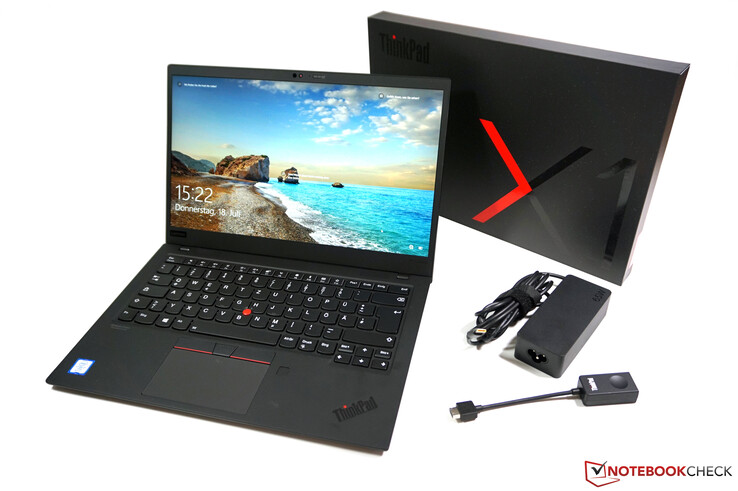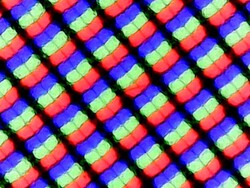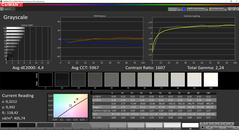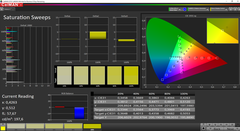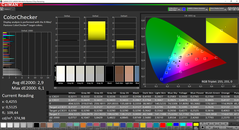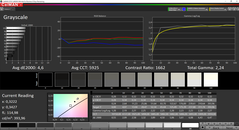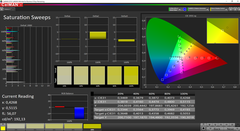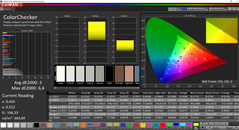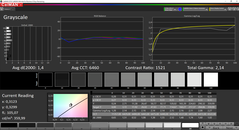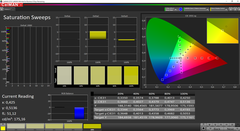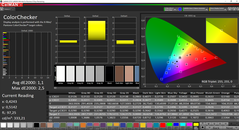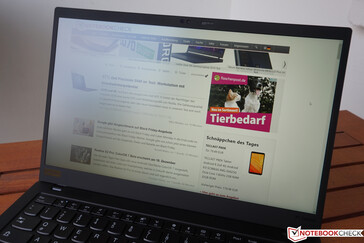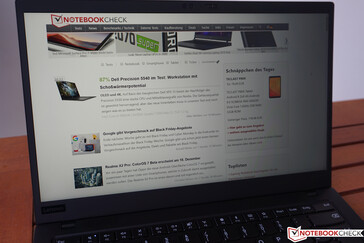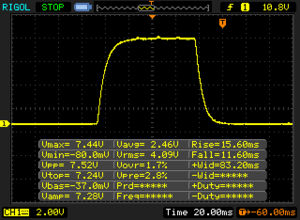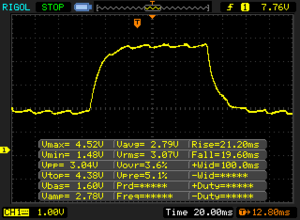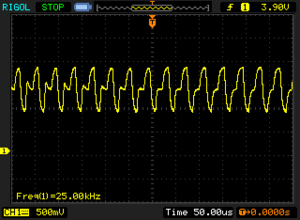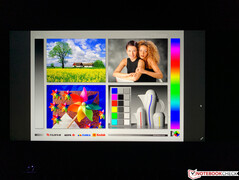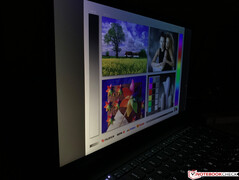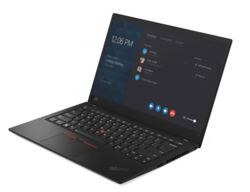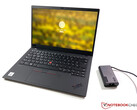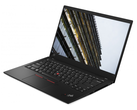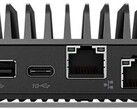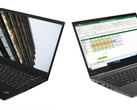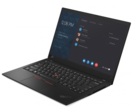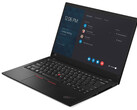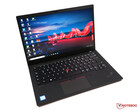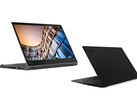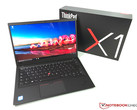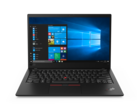Lenovo ThinkPad X1 Carbon 2019 Privacy Guard Review: Business laptop with ePrivacy filter is not perfect
We have already reviewed the 2019 model of the ThinkPad X1 Carbon two times, once with the Low Power 1080p screen as well as the familiar WQHD panel. Lenovo now also offers units with the Privacy Guard 1080p screen, which includes a privacy filter (ePrivacy). This is a direct competitor for HP's SureView technology, which is available in its third generation by now.
We focus on the screen quality and the effectiveness of the privacy filter in this review. More details on other review sections are available in our previous reviews of the ThinkPad X1 Carbon 2019:
Size Comparison
The selection of the Privacy Guard screen also results in a higher weight (~100 grams/~3.5 oz). While the X1 Carbon 2019 with the Low Power 1080p screen tipped the scale at 1.113 kg (~2.45 lb), we can now measure 1.226 kg (~2.7 lb). The Privacy Guard SKU is also slightly thicker by about half a millimeter (~0.02 in). However, you will not notice the difference unless you can compare the two units directly.
Connectivity – Wi-Fi 6 only as an option for the ThinkPad
The ThinkPad X1 Carbon 2019 is unfortunately not shipped with a Wi-Fi 6 module by default (Intel AX201), but with the familiar Intel Wireless-AC 9560 card instead. We have upgraded our Wi-Fi router (Netgear Nighthawk RAX200) for our standardized WLAN test since our last review of the X1 Carbon, and the results with the 9560 are much better. Compared to our previous router, the transfer speeds are almost doubled and the newer Wi-Fi 6 card (here shown by the Lenovo Yoga C740-15) is not much faster, either.
Display – Privacy Guard with good picture quality
After we had the chance to test all four different versions of Lenovo's new 1080p Low Power screen, it is now time for the optional FHD display with the integrated ePrivacy filter (Innolux N140HCR-GA2). The specs are basically identical with the Low Power SKUs: 1080p resolution, IPS technology, and a matte screen surface.
Subjectively, the image quality is good and comparable to the regular 1080p LP display. Working with the screen is no problem and the picture quality is very good for a business laptop. There is no visible grain, even on bright surfaces, despite the matte coating. We did not detect PWM (also the case for active privacy filter), only a background flickering at 25 kHz when the brightness drops to 50 or lower. This frequency should not be an issue even for sensitive users though. Great: Our unit does not show any signs of backlight bleeding.
| |||||||||||||||||||||||||
Brightness Distribution: 88 %
Center on Battery: 407 cd/m²
Contrast: 1624:1 (Black: 0.25 cd/m²)
ΔE ColorChecker Calman: 2.9 | ∀{0.5-29.43 Ø4.77}
calibrated: 1.1
ΔE Greyscale Calman: 4.4 | ∀{0.09-98 Ø5}
98.6% sRGB (Argyll 1.6.3 3D)
63.4% AdobeRGB 1998 (Argyll 1.6.3 3D)
70.3% AdobeRGB 1998 (Argyll 3D)
98.6% sRGB (Argyll 3D)
68.3% Display P3 (Argyll 3D)
Gamma: 2.24
CCT: 5967 K
| Lenovo ThinkPad X1 Carbon 2019-20QD00M7GE N140HCR-GA2, IPS, 1920x1080, 14" | Lenovo ThinkPad X1 Carbon 2019-20QE000VGE LP140QH2-SPD1, IPS, 2560x1440, 14" | Lenovo ThinkPad X1 Carbon 2019-20QES01L00 LP140WF9_SPF1, IPS, 1920x1080, 14" | HP EliteBook x360 830 G6 M133NVFC R5, IPS LED, 1920x1080, 13.3" | |
|---|---|---|---|---|
| Display | 3% | -5% | -3% | |
| Display P3 Coverage (%) | 68.3 | 72.5 6% | 64.5 -6% | 66.1 -3% |
| sRGB Coverage (%) | 98.6 | 97.8 -1% | 95.8 -3% | 95.3 -3% |
| AdobeRGB 1998 Coverage (%) | 70.3 | 73.8 5% | 65.7 -7% | 67.5 -4% |
| Response Times | 15% | -6% | -9% | |
| Response Time Grey 50% / Grey 80% * (ms) | 40.8 ? | 33.6 ? 18% | 44.8 ? -10% | 44 ? -8% |
| Response Time Black / White * (ms) | 27.2 ? | 24 ? 12% | 27.6 ? -1% | 30 ? -10% |
| PWM Frequency (Hz) | 25000 ? | 952 ? | ||
| Screen | -29% | -11% | 13% | |
| Brightness middle (cd/m²) | 406 | 338 -17% | 381 -6% | 603 49% |
| Brightness (cd/m²) | 372 | 315 -15% | 375 1% | 692 86% |
| Brightness Distribution (%) | 88 | 88 0% | 94 7% | 69 -22% |
| Black Level * (cd/m²) | 0.25 | 0.43 -72% | 0.24 4% | 0.26 -4% |
| Contrast (:1) | 1624 | 786 -52% | 1588 -2% | 2319 43% |
| Colorchecker dE 2000 * | 2.9 | 4 -38% | 4.6 -59% | 2.2 24% |
| Colorchecker dE 2000 max. * | 6.1 | 7.9 -30% | 8.5 -39% | 7.7 -26% |
| Colorchecker dE 2000 calibrated * | 1.1 | 1.7 -55% | 1.2 -9% | 1.5 -36% |
| Greyscale dE 2000 * | 4.4 | 6.2 -41% | 5.1 -16% | 2.6 41% |
| Gamma | 2.24 98% | 2.13 103% | 2.52 87% | 2.17 101% |
| CCT | 5967 109% | 6787 96% | 7052 92% | 6412 101% |
| Color Space (Percent of AdobeRGB 1998) (%) | 63.4 | 68.1 7% | 60.7 -4% | 60.2 -5% |
| Color Space (Percent of sRGB) (%) | 98.6 | 97.8 -1% | 95.7 -3% | 93.6 -5% |
| Total Average (Program / Settings) | -4% /
-17% | -7% /
-10% | 0% /
7% |
* ... smaller is better
Our measurement results are very similar to the previously tested 1080p Low Power screen. We can only confirm the advertised luminance of 400 nits for one spot; the average brightness is still good at ~370 nits. Thanks to the low black value, you can enjoy an excellent contrast ratio of more than 1600:1.
We use the professional CalMAN Ultimate software in combination with the X-Rite i1 Pro2 photo spectrometer for our analysis. There are some deviations compared to the sRGB reference color space out of the box, and there is a visible color cast towards yellow in combination with a slightly too warm color temperature. However, we are positively surprised by the picture quality when we turn on the privacy filter, because it does not affect the image quality at all.
Our calibration shows the real potential of the Innolux panel. The corresponding icm profile is linked in the box above and you can download it for free. Both the deviations for the grayscale and the colors are within the important limit of 3, and the color cast is gone as well. We determine an almost complete sRGB coverage (98.6%; AdobeRGB: 63.4%), so the display is also suited for picture editing.
Display Response Times
| ↔ Response Time Black to White | ||
|---|---|---|
| 27.2 ms ... rise ↗ and fall ↘ combined | ↗ 15.6 ms rise | |
| ↘ 11.6 ms fall | ||
| The screen shows relatively slow response rates in our tests and may be too slow for gamers. In comparison, all tested devices range from 0.1 (minimum) to 240 (maximum) ms. » 68 % of all devices are better. This means that the measured response time is worse than the average of all tested devices (20.2 ms). | ||
| ↔ Response Time 50% Grey to 80% Grey | ||
| 40.8 ms ... rise ↗ and fall ↘ combined | ↗ 21.2 ms rise | |
| ↘ 19.6 ms fall | ||
| The screen shows slow response rates in our tests and will be unsatisfactory for gamers. In comparison, all tested devices range from 0.165 (minimum) to 636 (maximum) ms. » 63 % of all devices are better. This means that the measured response time is worse than the average of all tested devices (31.6 ms). | ||
Screen Flickering / PWM (Pulse-Width Modulation)
| Screen flickering / PWM detected | 25000 Hz | ≤ 50 % brightness setting | |
The display backlight flickers at 25000 Hz (worst case, e.g., utilizing PWM) Flickering detected at a brightness setting of 50 % and below. There should be no flickering or PWM above this brightness setting. The frequency of 25000 Hz is quite high, so most users sensitive to PWM should not notice any flickering. In comparison: 53 % of all tested devices do not use PWM to dim the display. If PWM was detected, an average of 8084 (minimum: 5 - maximum: 343500) Hz was measured. | |||
Privacy Guard
We have already shown that the use of the privacy filter does not affect the image quality or brightness, respectively, which is a big advantage over HP's SureView technology. HP only managed to improve the picture quality with the third generation of SureView, which we reviewed in combination with the EliteBook x360 830 G6, for instance. However, we have to be fair and mention that HP offers SureView in combination with a matte touch screen, while Lenovo uses a standard IPS screen without touch support.
But how effective is Lenovo's privacy filter? First of all, you should know that the viewing angle stability is limited compared to standard IPS screens even when the privacy functionality is turned off. The brightness drops more quickly with horizontal shifts, but this is the case for Lenovo's Privacy Guard as well as HP's SureView.
As soon as you activate the privacy filter ("FN" + "D"), Lenovo automatically reduces the screen brightness to around 90 Nits. The image is now harder to see from an angle, but you notice a blue hint. You can increase the brightness manually up to the maximum, but this reduces the effect of the privacy filter noticeably. This means that the filter does not really work in bright environments where you need the highest display brightness. HP's SureView technology is better in this respect. We have recorded the viewing angles of the X1 Carbon 2019 Privacy Guard in the video below (ePrivacy off, ePrivacy on, ePrivacy on max. brightness).
We used the ThinkPad X1 Carbon a couple of times and also tested it on a train ride. Due to bad weather and the time we did not have to use the maximum luminance, which is why the privacy filter worked well. This is a scenario where the optional Privacy Guard screen can make sense. However, we would like to see a more effective filter for the next generation – especially at higher brightness levels.
Battery Runtime – Privacy Guard reduces stamina
In addition to the increased weight, the Privacy Guard display also consumes more power than its LowPower counterpart. We determine about 7.5 hours in our standard Wi-Fi test at 150 Nits. Not bad in general, but the X1 Carbon 2019 with the LP-1080p-screen lasts almost two hours longer. The runtime is reduced to just 5 hours when we repeat the test with the maximum luminance. The use of the privacy filter has no effect on the power consumption.
| Lenovo ThinkPad X1 Carbon 2019-20QD00M7GE 51 Wh, 1920x1080 | Lenovo ThinkPad X1 Carbon 2019-20QE000VGE 51 Wh, 2560x1440 | Lenovo ThinkPad X1 Carbon 2019-20QES01L00 51 Wh, 1920x1080 | Average of class Office | |
|---|---|---|---|---|
| Battery Runtime | 8% | 24% | 70% | |
| WiFi Websurfing (h) | 7.6 | 8.2 8% | 9.4 24% | 12.5 ? 64% |
| WiFi Websurfing max. Brightness (h) | 5 | 8.79 ? 76% |
Pros
Cons
Verdict – Privacy Guard ThinkPad with room for improvements
You have to pay $197 extra for the ePrivacy display compared to the regular 1080p screen (400 nits). The picture quality as well as the brightness are pretty similar between these two models and the overall picture impression is very good. However, the viewing angles of the ePrivacy screen are more limited even without the privacy filter running, because the brightness drops pretty quickly with horizontal shifts. We think the panel is not worth it for all users since the privacy filter is only really effective at low brightness levels. HP's current SureView generation definitely has an advantage in this regard, even though the picture quality is more affected due to the manufacturing process. HP also offers a matte touchscreen.
Lenovo's ePrivacy screen is only effective at low brightness levels, but there are at least no negative effects on the picture quality. This is not a bad result for the first attempt, but there is still plenty of room for improvements.
Lenovo's first attempt for a privacy filter is certainly not bad, but it has to be improved to be really effective. It currently only works well at low brightness levels. HP's SureView filter, however, has improved significantly with the third generation, because the first two versions had major effects on the picture quality and it was not really suited for longer work sessions.
If you want to buy a current ThinkPad X1 Carbon, you should also consider the negative aspects of the Privacy Guard panel. Besides the slightly higher weight and the slightly thicker chassis, we are mainly talking about the reduced battery runtime, which can be important for such a mobile device. It is certainly no mistake to choose the ePrivacy screen though. All the other advantages and disadvantages are obviously transferred from the other ThinkPad X1 Carbon SKUs.
Lenovo ThinkPad X1 Carbon 2019-20QD00M7GE
- 12/25/2019 v7 (old)
Andreas Osthoff





